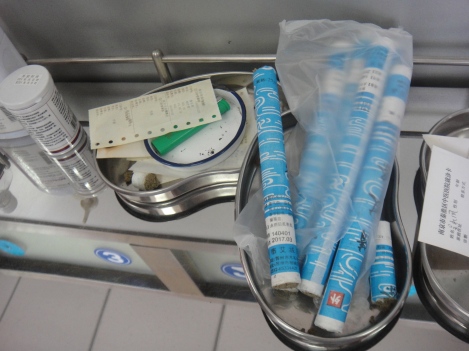Qin Huai TCM Hospital is reputedly one of two most famous hospitals in China for moxibustion and the most famous moxibustion hospital in this province. For those who don’t know, moxibustion is a heat therapy that involves burning different preparations of a certain herb (mugwort, aka Ai Ye) near or on the patient. There’s one style of moxa called direct moxa, which involves making small “cones” of the moxa, applying a salve to a point on the body, then lighting the small cone of moxa directly on the skin (buffered by the salve). It’s snuffed out or pinched out before it burns the skin. That’s the one kind of moxibustion I actually didn’t see at Qin Huai. I did see indirect moxa, which involves burning the moxa in a pole form and using it to heat the patients without actually touching them. (Notably, I saw three of these poles being burned together held near a patient’s ear to treat deafness and tinnitus. Quite smoky!)

A third kind we commonly use in the US is called warming needle, in which the moxa is burned in a ball at the tip of the needle. The heat transfers through the metal of the needle into the acupoint beneath the skin. At Qin Huai, they use pieces of the pole-wrapped moxa, which comes with hand perforations so you can break off small chunks. This saves you the trouble of rolling up a ball from loose moxa, and they burn quite well.

I’ve also seen a few kinds of moxibustion done here that I’ve never seen before. One is called dynamic moxa, which they invented here at this hospital. I had a chance to try it today from the patient end, and it felt amazing. They take a moxa pole and wrap it in a damp paper towel and cloth, then use it to apply both heat and pressure with a fast-moving rolling technique, very similar to the special “rolling” manual technique in Chinese therapeutic massage (Tuina). The cloth is damp with a special herbal formula made of blood-moving herbs (which are especially good to relieve pain from blood stagnation), so this technique is a brilliant blend of moxibustion, Tuina massage, and topical herbal medicine. It feels really nice, both massaging and warming the muscles. I’m a definite fan.



The key is to hold the dynamic moxa thusly, relax your wrist as in the Tuina rolling technique, and keep it moving so it’s not too hot. The moxa pole snuffs out after a bit and stops being warm, so it’s important to re-light or replace it every couple of minutes.

Another cool kind of moxibustion we saw is called Bie Jia moxa. Bie Jia is the name for a tortoise shell when used as a Chinese herb. In Bie Jia moxa, a big pile of moxa is burned on top of a tortoise shell, which is placed on the patient’s belly. Because of the properties of this herb, this is an especially nourishing technique. We saw it used on a woman with a thin endometrium coming in for fertility support.

I’ve heard of moxibustion being burned on top of slices of fresh ginger or aconite (Fu Zi), utilizing the therapeutic effects of those herbs, but this particular method using tortoise shell was new to me.

Yet another kind I’d heard of but never seen, called walnut moxa. Basically this is a technique for applying moxibustion to the face, which is fantastic for facial paralysis, while protecting the eye. This is especially relevant when the patient can’t completely close his or her eyelid. A half of a walnut shell is used to protect the eye, and a piece of burning moxa pole is held near the eye with a wire contraption resembling eyeglasses.


And here it is, burning and ready to be picked up by the patient. The lady we saw using this most consistently had facial paralysis with a drooping right eye. We didn’t see much improvement the first week (more up and down) but on Friday the doctor pointed out increased mobility of her eyelid and cheek and told us that because of this good sign, he expected faster recovery to begin shortly. When we saw her the following Monday, there was very marked improvement in how far her eyelid could stay open (she also had acupuncture, and her treatments were 5-6 days per week). The patient picks up the eyeglass device and wears it with the walnut shell protecting the eye until the smoke goes out.

The last kind of moxa I’ll point out was a strange combination of electro-acupuncture therapy and moxibustion that I’d never heard of. The moxa is contained in these hat-like bundles and are then connected to an electric device like a TENS machine. Electricity is then sent through the moxibustion, providing heat. Apparently this is best for focal disorders when you need the heat to penetrate deeply.

We saw it used on only one patient, a butcher coming in with arm pain centered on a small area by the elbow. I have no idea how well this therapy works, but it was interesting. The little hats of moxa were hooked up to a specialized machine and wrapped around his elbow, where his pain was localized.

Although acupuncture is the face of Chinese Medicine in the West, it is often known to those in the know as acupuncture and moxibustion. Moxa is a major modality in itself, on a level with acupuncture and therapeutic massage. Of course, this leaves out the enormous field of Chinese herbal medicine, but we will save that for another post.
One thought on “Qin Huai Hospital Shift – Moxa!”